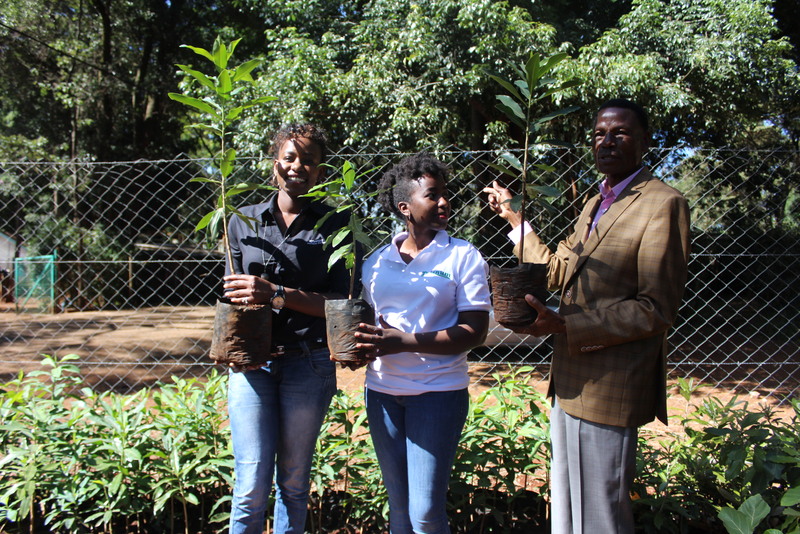
Koppert Kenya partners with Karura Forest for biological control in the urban forest
Koppert Kenya has collaborated with Karura Forest in ongoing trials to test the efficacy of using biological control to manage soil-borne diseases in tree seedlings. This has been undertaken at the Kenya Forestry Research Institute (KEFRI) nurseries in Kiambu County. The collaboration is a natural extension to Koppert Kenya’s commitment to sustainability and making agriculture healthier and safer.
“Karura Forest faces several challenges. One major challenge is fungal attack of seedlings. The intensity of fungal attacks varies from species to species, with some species like Prunus africana being highly susceptible. Fungal attacks result in 50-80% loss of seedlings” said Mr. Fredrick Mutisya, Assistant Forester at Karura Forest.
Karura Forest station is an urban forest in Nairobi which covers 1,041 hectares. To protect the numerous species of tree seedlings in the nurseries, the foresters mainly use cultural control methods to keep the plants healthy. However, this means that they are susceptible to fungal attacks and root diseases in the seedling nurseries and germination beds. The seedlings are particularly susceptible to several fungal diseases because of their tender tissues. Root and butt rot caused by a species of Armillaria is one of the most serious diseases of fruit and forest trees. These harmful pathogens cause diseases of the roots or stem and disrupt uptake of water and nutrients from the soil. This may lead to reduced yield, wilting, yellowing, leaf fall, stunting and even death of the trees.
In December 2015, Koppert drenched more than 450,000 tree seedlings at the nurseries in Karura Forest with Trianum as a Corporate Social Responsibility (CSR) initiative. Trianum is a beneficial fungi based on the Trichoderma harzianum strain T-22. Trianum offers the best protection against soil borne fungi such as Pythium, Rhizoctonia and Fusarium and improves plant strength, allowing plants to grow more healthily and uniformly.
“Loss of the fertile top layer of soil due to erosion and expanding rangelands are some of the challenges that we face in agriculture. For us to mitigate these challenges, planting trees is the best solution. Therefore, we have to do everything possible to ensure healthy trees. That is why we are partnering with Koppert to use biological control to produce good, healthy seedlings.” explained Mr. John Orwa, the Forester at Karura Forest.
One of the mandates of the foresters at Karura Forest is to encourage people to plant trees in order for Kenya to achieve 10% forest cover by 2030 as required by the United Nations. This is important because forests are key to supporting life on earth. The United Nations Food and Agricultural Organization reports that up to three quarters of the world’s biodiversity is hosted in forests. With increasing awareness of the need to preserve the numerous and fundamental functions of trees, it has never been more important to invest in the sustainable management of our forests.
Biological control is an important tool that should be applied in protecting forest trees and especially tree seedlings. Biological control involves the use of living organisms to manage pest populations, making them less economically damaging than they would otherwise be. Trichoderma harzianum has been found to be most effective in inhibiting the growth of fungal diseases. The fungus can protect the trees by establishing itself on the root zone of the trees, forming a physical barrier against attack from pathogens and promotes healthy root development, leading to improved uptake of water and nutrients. This results in stronger and healthier trees that are more resistant to stress caused by diseases, sub-optimal feeding or climatic conditions.
Continued observation of tree seedlings treated with Trianum revealed that a number of tree species responded quite well. By early March, Markhamia (Markhamia lutea) and Nandi flame (Spathodia nilotica) species especially showed extreme positive response in terms more vigorous growth and vegetation.
“Indigenous trees such as Markhamia and Nandi flame are much better at conserving the environment than exotics due to their broad canopies and strong rooting systems. That is why we encourage people to plant more indigenous trees than exotics. However, indigenous trees are more difficult to propagate than exotics. Some species can take several weeks or even months to germinate. For this reason, I think the biological control methods might prove effective but we shall take more time to make our observations,” Mr. John Orwa pointed out.
Against the backdrop of the global celebration of forests on 21st March - the International Day of Forests- Koppert hopes to continue this progressive partnership with Karura Forest in order to enhance the survival and continued regeneration of the remarkable Karura Forest.